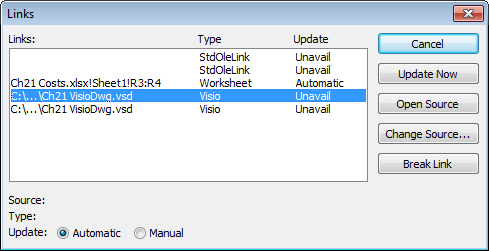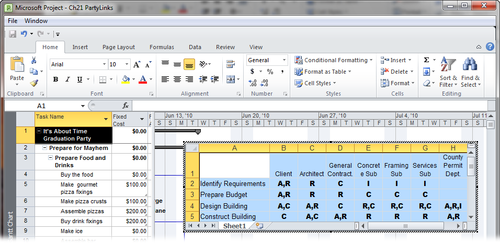Linking or embedding information into another file is
just the beginning. Linked and embedded objects are incredibly
versatile, and this section shows you all the things you can do with
them. Most of the time, you want the information in linked and embedded
objects to be visible at all times, but these objects can just as easily
keep a low profile as icons until you want to see what they have to
show. Like other elements in files, you can move or resize objects—for
instance, to get them out of the way of task bars in a Gantt Chart or
graphics on a Visio diagram. And the whole point of inserting a linked
or embedded object instead of a picture is to edit it at some point. For
linked and embedded objects to work, you need to know how to manage links between files, and this section explains that as well.
Linked
and embedded objects work like many other elements in your files. You
can select them, move them around, change their size, and delete them.
Here's how:
Resize an object.
When you select an object by clicking it, resize handles appear at each
corner and at the middle of each side. You can drag these handles to
change the size of the object. To change the object dimensions while
maintaining its proportion, drag a handle at one of the corners. The
pointer changes to an angled two-headed arrow. To change the size in
only one dimension, drag a handle at the middle of a side. The pointer
changes to either a horizontal or vertical two-headed arrow.
Move an object.
You can move an object whether or not it's selected by dragging the
middle of the object to the new location. The pointer changes to a
four-headed arrow to indicate that you're about to move the object. If
you drag too close to an edge, then the object resizes instead.
Delete an object. Select the object, and then press Delete.
Display the object behind an icon.
When you choose to display an object as an icon, double-click the icon
to bring the full object into view. Dragging an icon moves the object,
just as dragging the actual object does.
1. Editing Linked Objects
Whether
you're working in the source program or container program when you edit
a linked object, you always edit the same source file. Suppose you link
an Excel spreadsheet to your Gantt Chart timescale. If you edit the
spreadsheet in Excel, then the changes you make show up automatically
the next time you open or update your Project file. On the other hand,
you can double-click the linked object in Project to start Excel and
open the source file for editing.
Editing linked objects works differently from editing embedded objects in that you always do your editing in the source file. Here's how it works:
To edit a linked object, double-click it.
The
source file opens in the source program. For example, double-clicking a
linked Excel spreadsheet starts Excel and opens the spreadsheet—as if
you'd started Excel yourself and opened the file. You must have
read-write privileges for the file in order to edit it, just as you
would if you opened the file directly. The box on Opening Reluctant Links explains your options if an error message appears when you try to edit a linked object.
When
you see the message box telling you that you're opening an OLE object
that could contain viruses and other malicious code, if you're sure it's
safe, click Yes to open the file.
If you have any doubts about the file, click No.
When you finish editing, save the file as you would normally, and then close the object's program (Excel in this example).
Back
in the container file, the linked object displays the changes. If the
linked object isn't up to date, you can tell the container program to
immediately check for updates, as described in the next section.
If
an error message appears when you try to edit a linked object (or when
you open a file with links), a broken link is the most likely suspect.
Links are smart enough to change if you rename the file or move it to a
new folder on the same drive. However, if the linked file moves to a
different file server, you must edit the link to point to the correct
file location (Section 21.3.2). Alternatively,
if the file location is fine, then the problem could be that the file
is already open in its source program. Your easiest fix is editing the
file there. The last reason for problems editing
links is that the source program isn't installed on your computer. For
example, when you edit a linked Visio drawing, Visio starts and opens
the file, which means you must have Visio on your computer. |
2. Managing Linked Objects
Linked
objects require ongoing care and feeding. For example, you must make
sure that links can find the files they represent. If links are broken,
then you can redirect them to the correct location for the source file.
Conversely, you can intentionally break the link between an object and
the source file to transform the object into an embedded object or
picture. Finally, you can update a link immediately and tell the
container program whether you want it to update links automatically or
wait for you to say when.
The Links dialog box, shown in Figure 1, is where you begin link management tasks. The Edit Links command isn't on the ribbon, so you must add it to a custom group before you can use it.
Here's how to keep links in tip-top condition:
Review links.
The Edit Links dialog box lists the links in your file whether they
connect to other places in the same file or different files altogether.
When you select a link in the list, the Source line shows the path and
filename at the bottom of the dialog box. The Type line indicates the
type of file.
Update a link. To immediately update a link with changes from the source file, select the link, and then click Update Now.
Note:
When
you open a file with links, a message box asks whether you want to
update the links. Click Yes to display the most recent data from the
linked file.

Repair a broken link.
You can fix broken links by changing the folder or file that a link
looks for. Click Change Source. In the Change Source dialog box, click
Browse to find the file. Double-click the filename to update the path
and name in the Source box. Click OK to save the link.
Change a linked object into an embedded object.
Suppose you linked to a document during its development so you always
saw the most recent version. Now that the document is approved, you want
to embed it so you can see the document without the baggage of
maintaining the link. You can convert a linked object into an embedded
object in the Edit Links dialog box by selecting the link and then
clicking Break Link. The link disappears from the list in the Links
dialog box, but the object remains, and now acts like the embedded
object it is.
Specify when to update the link.
Initially, Project and other programs create links so they update
automatically, which means that the container program checks source
files for changes and updates the objects with any changes it finds. All
that checking and updating can slow your program to a crawl, especially
if the source files change frequently or are located on large or
complex networks. In this situation, you can control when updates occur
by selecting a link, and then selecting the Manual option.
3. Editing Embedded Objects
You
double-click embedded objects to edit them, just like you do linked
objects. The result, in most cases, is that the menus for the container
program change to the menus for the embedded object's program. For
example, when you double-click an Excel spreadsheet embedded in your
Gantt Chart, Excel menus appear where the Project menus just were, as
illustrated in Figure 2.
You can work on the Excel object as if you were working directly in
Excel. When you're done, click away from the embedded object, and the
Project menus reappear. It's like having two programs at your
fingertips.

If
you embed an object in a Project task's note (select the task and
choose Task→Properties→Information, click the Notes tab, and then click
the Insert Object icon), then double-clicking the embedded object opens
the object in the source program. However, if you click the File tab in
that program, the heading on the Info screen says "Information about
Embedded Object"—which is your clue that you aren't editing a source
file.